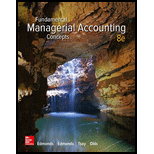
Fundamental Managerial Accounting Concepts
8th Edition
ISBN: 9781259569197
Author: Thomas P Edmonds, Christopher Edmonds, Bor-Yi Tsay, Philip R Olds
Publisher: McGraw-Hill Education
expand_more
expand_more
format_list_bulleted
Question
Chapter 10, Problem 10ESB
a.
To determine
Calculate the internal rate of
b.
To determine
State the alternative that the Company should select based on the internal
c.
To determine
Identify the two other evaluation techniques that Person H should use to compare the investment opportunities.
Expert Solution & Answer
Want to see the full answer?
Check out a sample textbook solution
Students have asked these similar questions
I need help with this general accounting problem using proper accounting guidelines.
general accounting
Can you solve this general accounting question with accurate accounting calculations?
Chapter 10 Solutions
Fundamental Managerial Accounting Concepts
Ch. 10 - Prob. 1LOCh. 10 - Prob. 2LOCh. 10 - Prob. 3LOCh. 10 - Prob. 4LOCh. 10 - Prob. 1QCh. 10 - Prob. 2QCh. 10 - Prob. 3QCh. 10 - Prob. 4QCh. 10 - Prob. 5QCh. 10 - Prob. 6Q
Ch. 10 - Prob. 7QCh. 10 - Prob. 8QCh. 10 - Prob. 9QCh. 10 - Prob. 10QCh. 10 - Prob. 11QCh. 10 - Prob. 12QCh. 10 - Prob. 13QCh. 10 - Prob. 14QCh. 10 - Prob. 15QCh. 10 - Prob. 16QCh. 10 - Prob. 17QCh. 10 - Prob. 18QCh. 10 - Prob. 19QCh. 10 - Prob. 20QCh. 10 - Prob. 21QCh. 10 - Prob. 22QCh. 10 - Prob. 23QCh. 10 - Prob. 1ESACh. 10 - Prob. 2ESACh. 10 - Prob. 3ESACh. 10 - Prob. 4ESACh. 10 - Prob. 5ESACh. 10 - Prob. 6ESACh. 10 - Prob. 7ESACh. 10 - Prob. 8ESACh. 10 - Prob. 9ESACh. 10 - Prob. 10ESACh. 10 - Prob. 11ESACh. 10 - Prob. 12ESACh. 10 - Prob. 13ESACh. 10 - Prob. 14ESACh. 10 - Prob. 15ESACh. 10 - Prob. 16PSACh. 10 - Prob. 17PSACh. 10 - Prob. 18PSACh. 10 - Prob. 19PSACh. 10 - Prob. 20PSACh. 10 - Prob. 21PSACh. 10 - Prob. 22PSACh. 10 - Prob. 23PSACh. 10 - Prob. 1ESBCh. 10 - Prob. 2ESBCh. 10 - Prob. 3ESBCh. 10 - Prob. 4ESBCh. 10 - Prob. 5ESBCh. 10 - Prob. 6ESBCh. 10 - Prob. 7ESBCh. 10 - Prob. 8ESBCh. 10 - Prob. 9ESBCh. 10 - Prob. 10ESBCh. 10 - Prob. 11ESBCh. 10 - Prob. 12ESBCh. 10 - Prob. 13ESBCh. 10 - Prob. 14ESBCh. 10 - Prob. 15ESBCh. 10 - Prob. 16PSBCh. 10 - Problem 10-17B Applying the net present value...Ch. 10 - Prob. 18PSBCh. 10 - Prob. 19PSBCh. 10 - Prob. 20PSBCh. 10 - Prob. 21PSBCh. 10 - Prob. 22PSBCh. 10 - Prob. 23PSBCh. 10 - Prob. 1ATCCh. 10 - Prob. 4ATCCh. 10 - Prob. 5ATCCh. 10 - Prob. 6ATCCh. 10 - Prob. 7ATCCh. 10 - Prob. 1CP
Knowledge Booster
Similar questions
- Accounting?arrow_forwardExpand upon it and add more infoarrow_forwardJH, Inc., is a calendar year, accrual basis corporation with Joe as its sole shareholder (basis in his stock is $90,000). On January 1 of the current year, JH Corporation has accumulated E & P of $200,000. Before considering the effect of the distribution described below, the corporation’s current E & P is $50,000. On November 1, JH distributes an office building to Joe. The office building has an adjusted basis of $80,000 (fair market value of $100,000) and is subject to a mortgage of $110,000. Assume that the building has been depreciated using the ADS method for both income tax and E & P purposes. What are the tax consequences of the distribution to JH and to Joe? (In your answer, be sure to describe the effects on taxable income for both JH and Joe, the impact of the distribution on JH’s E & P, and Joe’s basis in the building.)arrow_forward
- Joe is the sole shareholder of JH Corporation. Joe sold his stock to Ethan on October 31 for $150,000. Joe’s basis in JH stock was $50,000 at the start of the year. JH distributed land to Joe immediately before the sale. JH’s basis in the land was $20,000 (fair market value of $25,000). On December 31, Ethan received a $75,000 cash distribution from JH. During the year, JH has $20,000 of current E & P and its accumulated E & P balance on January 1 is $10,000. Which of the following statements is true? a. Joe recognizes a $110,000 gain on the sale of his stock. b. Joe recognizes a $100,000 gain on the sale of his stock. c. Ethan receives $5,000 of dividend income.d. Joe receives $20,000 of dividend income. e. None of the above.arrow_forwardPlease provide the accurate answer to this general accounting problem using appropriate methods.arrow_forwardPlease provide the accurate answer to this general accounting problem using appropriate methods.arrow_forward
arrow_back_ios
SEE MORE QUESTIONS
arrow_forward_ios
Recommended textbooks for you

 AccountingAccountingISBN:9781337272094Author:WARREN, Carl S., Reeve, James M., Duchac, Jonathan E.Publisher:Cengage Learning,
AccountingAccountingISBN:9781337272094Author:WARREN, Carl S., Reeve, James M., Duchac, Jonathan E.Publisher:Cengage Learning, Accounting Information SystemsAccountingISBN:9781337619202Author:Hall, James A.Publisher:Cengage Learning,
Accounting Information SystemsAccountingISBN:9781337619202Author:Hall, James A.Publisher:Cengage Learning, Horngren's Cost Accounting: A Managerial Emphasis...AccountingISBN:9780134475585Author:Srikant M. Datar, Madhav V. RajanPublisher:PEARSON
Horngren's Cost Accounting: A Managerial Emphasis...AccountingISBN:9780134475585Author:Srikant M. Datar, Madhav V. RajanPublisher:PEARSON Intermediate AccountingAccountingISBN:9781259722660Author:J. David Spiceland, Mark W. Nelson, Wayne M ThomasPublisher:McGraw-Hill Education
Intermediate AccountingAccountingISBN:9781259722660Author:J. David Spiceland, Mark W. Nelson, Wayne M ThomasPublisher:McGraw-Hill Education Financial and Managerial AccountingAccountingISBN:9781259726705Author:John J Wild, Ken W. Shaw, Barbara Chiappetta Fundamental Accounting PrinciplesPublisher:McGraw-Hill Education
Financial and Managerial AccountingAccountingISBN:9781259726705Author:John J Wild, Ken W. Shaw, Barbara Chiappetta Fundamental Accounting PrinciplesPublisher:McGraw-Hill Education


Accounting
Accounting
ISBN:9781337272094
Author:WARREN, Carl S., Reeve, James M., Duchac, Jonathan E.
Publisher:Cengage Learning,

Accounting Information Systems
Accounting
ISBN:9781337619202
Author:Hall, James A.
Publisher:Cengage Learning,

Horngren's Cost Accounting: A Managerial Emphasis...
Accounting
ISBN:9780134475585
Author:Srikant M. Datar, Madhav V. Rajan
Publisher:PEARSON

Intermediate Accounting
Accounting
ISBN:9781259722660
Author:J. David Spiceland, Mark W. Nelson, Wayne M Thomas
Publisher:McGraw-Hill Education

Financial and Managerial Accounting
Accounting
ISBN:9781259726705
Author:John J Wild, Ken W. Shaw, Barbara Chiappetta Fundamental Accounting Principles
Publisher:McGraw-Hill Education